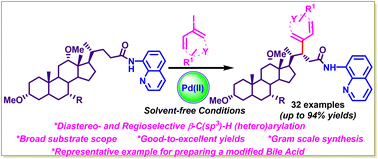Synthesis of modified bile acids via palladium-catalyzed C(sp3)–H (hetero)arylation†
Abstract
A Pd(II)-catalyzed strategy for the diastereo- and regioselective (hetero)arylation of unactivated C(sp3)–H bonds in bile acids is accomplished with aryl and heteroaryl iodides under solvent-free conditions using the 8-aminoquinoline auxiliary as a directing group. This methodology demonstrated excellent functional group tolerance with respect to aryl/heteroaryl iodides on O-protected N-(quinolin-8-yl)cholyl/deoxycholyl amides to afford β-C(sp3)–H (hetero)arylated products in good-to-excellent yields. Moreover, the 8-aminoquinoline (AQ) auxiliary can easily be removed to obtain modified bile acids.



 Please wait while we load your content...
Please wait while we load your content...